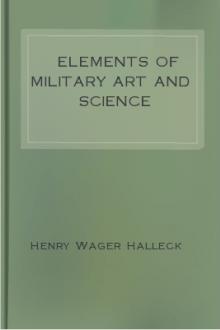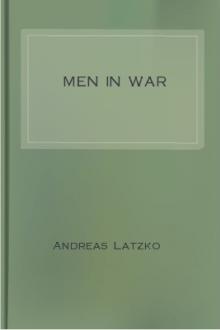Elements of Military Art and Science by Henry Wager Halleck (books you have to read txt) 📕

- Author: Henry Wager Halleck
- Performer: -
Book online «Elements of Military Art and Science by Henry Wager Halleck (books you have to read txt) 📕». Author Henry Wager Halleck
History furnishes us numerous examples of the use of artillery in protecting avenues of approach:—such as the defile of Köesen at the battle of Auerstedt; the avenues between the redoubts of Pultowa, &c., &c.
When an army is forced to retreat, it covers its rear by that portion of its cavalry and mounted artillery which has suffered least during the battle. By placing the squadrons of horse and the light batteries in echelon, the retiring column may be well protected. The artillery, by using the prolonge, may also continue its retreat while in battery and firing. It was in this way that at the battle of Albuera, in 1811, the French artillery on the left wing held in check the right and centre of the Anglo-Spaniards till the army effected its retreat; the artillery then retired in echelons, by batteries and fractions of batteries, under the protection of the cavalry.
We have already discussed, under the general head of tactics, the position and use of artillery on the battle-field a few additional remarks must suffice.
As a general rule, batteries should be placed in positions from which they can employ their fire to advantage, and also be free to move in any direction that the progress of the battle may require. Advantage should always be taken of natural or artificial obstacles, such as hedges, clumps of trees, logs, mounds of earth, &c., to cover and conceal the guns till the moment they open their fire. Elevated positions are, contrary to the common opinion, generally unfavorable, for artillery cannot fire to advantage at any considerable angle of depression. The slopes in front should be of considerable length, otherwise the balls would do very little execution upon that portion of the column of attack which occupied the valley. The ground should also be smooth, for if rough the balls will either bury themselves in the earth, or ricochet at a high angle of deflection, thus destroying a considerable part of the effect of the fire. The counterforts or spurs of hills are favorable for artillery, as they enable it to see, with an enfilading fire, the slopes of the principal range. Batteries should seldom be placed so as to fire over other troops, for they will not only be intimidated by this fire, but also exposed to the opposing fire of the enemy's artillery. A large number of pieces should never be crowded into the same place, but an interval should be left between the guns of forty or fifty feet, according to the locality. The most favorable position for this arm in ordinary ground, is in the intervals between the regiments or brigades of the line, and far enough in advance of this line not to draw upon the other troops the fire of the enemy's artillery. The flanks of the line are also favorable for the action of this arm.
Sometimes artillery has been employed to form a part of the line of battle; but such instances are exceptions, and can never be comprised in general rules. Whenever this disposition has been made, it has resulted from the defective character of the other arms, or from some peculiar circumstance in the battle which enabled a bold and skilful commander to deviate from the ordinary rules of tactics. Such was the case with Napoleon at Wagram. In Saxony, in 1813, he was several times obliged to substitute his artillery to supply the want of other arms.
In the defence and attack of field-works, and in the passage of rivers, artillery plays an important and indispensable part; but it here becomes an auxiliary to the dispositions of the engineers, or at least acts in concert with that arm.
The troops of artillery, in all well-regulated army organizations, should equal about two-thirds of the cavalry, or one-seventh of the infantry.[36]
[36]
To qualify himself for the duties connected with his arm of service, the artillery officer must make himself thoroughly acquainted with—.
The Instruction for United States Field Artillery, horse and foot;
Capt. Anderson's Instruction for Garrison Artillery;
Kinsley's Notes on Pyrotechny;
Knowlton's Notes on Gunpowder,&c.; and
The writings of Thiroux and Piobert on theoretical and practical instruction, and the writings of Jomini, Decker, and Okotmeff, on the use of this arm on the field of battle.
The following list of books of reference may be of use to those who wish to make themselves perfectly familiar with all the branches of artillery.
Histoire général de l'artillerie. Brunet.
L'artillerie à cheval dans les combats de cavalerie. Par un officier de l'artillerie Prussienne.
Considérations et experiences sur le tir des obus à bulles. Bormann. Essai sur les obusiers. Dusaert.
Essai sur l'organisation de l'artillerie. Le Bourg.
Traité sur l'artillerie, (traduit de l'Allemand.) Rouvroy.
Bombardier Français. Bélidor.
Mémoires d'artillerie. St. Rémy.
Essai sur l'usage de l'artillerie dans la guerre de campagne et celle de siége. Dupuget.
Mémoires sur les nouveaux systèmes d'artillerie. St. Aubin.
Treatise on Artillery. Müller.
Artificial Fire-Works. Jones.
Table de tir les canons et obusiers. Lombard.
On Gunpowder. Antoni.
Recherches sur l'artillerie en général. Texier de Norbec.
Déscription de l'art de fabriquer les canons. Monge.
Procédés de la fabrication des armes blanches. Vandermonde.
Manuel de l'artilleur. Durtubie.
Traité du mouvement des projectiles. Lombard.
Treatise on Artillery. Scheel. (Translated from the German.)
Traité pratique des feux d'artifice. Morel.
Manuel du canonnier marin. Cornibert.
New Principles of Gunnery. Robins.
Mémoires sur la fabrication des armes portatives. Cotty.
Recherches sur la poudre. Cossigny.
Supplement. Cossigny.
Fabrication de la poudre. Renaud.
American Artillerist's Companion. Toussard.
Tables des portées des canons et canonades de la marine. Cornilwert.
Traité d'artifices de guerre. Bigot.
Traité élémentaire de la fabrication des bouches à feu. Dartein.
Traité de l'art de fabriquer la poudre à canon. Bottée et Riffault.
L'art du salpétrier. Bottée et Riffault.
Dictionary of Artillery. Hoyer. (German.)
New Experiments on Gunnery. Hutton—(Hutton's Tracts.)
Des bois propres au service des Arsenaux. Herbin de Halles.
Instruction sur le service de l'artillerie. Hulot.
Manœuvres de force. Bigot.
Balistique. Obenheim.
Treatise on Artillery. German. Scharnhorst. (Translated into French, 1840.)
Essai sur l'art de pointer. Poumet.
Réflexions sur la fabrication des bouches à feu. Lamartillière.
Mémoire sur la planchette du canonnier. Obenheim.
Aide-Mémoire. Gassendi.
Observations on the use of Artillery at the sieges of Badajos, St. Sebastian, etc..
Treatise on Artillery. Lallemand.
Elémens de pyrotechnie. Ruggieri.
Nouvelle force maritime. Paixhans.
Dictionnaire d'artillerie. Cotty.
Recherches balistiques. Coste.
Poudres fulminantes. Vergnaud.
Manuel de la métallurgie du fer. Culman.
Pyrotechnic militaire, (traduit de l'Allemand, par R. de Peretsdorff.)
Journal des Sciences Militaires.
Pyrotechny. Cutbush.
Traité élémentaire d'artillerie. Decker.
Fusées de guerre. Montgery.
Documens sur la matière à canons. Hervé.
Observations sur le nouveau système d'artillerie. Allix.
Système d'artillerie de campagne. Allix.
Pocket Gunner. Adye.
On the Rocket System. Congreve.
Essai sur l'art des fontes. Serres.
Receuil de Mémoires sur la poudre à canon. Proust.
Mémorial de l'artilleur marin. Michel.
Observations sur le nouveau système de l'artillerie. Poumet.
Mémorial d'artillerie.
British Gunner. Spearman.
Régles de pointage à bord des vaisseaux. Montgery.
Manuel du maître de forges. Landrin.
Naval Gunnery. Douglass.
Métallurgie du fer (traduit de l'Allemand, par Culman.) Karsten.
Aide-Mémoire à l'usage des officers d'artillerie. (Strasbourg.)
Traité de l'organisation et de la tactique de l'artillerie, (traduit de l'Allemand par Peretsdorff.) Grewenitz.
Supplement au dictionnaire d'artillerie. Cotty.
Memoir on Gunpowder. Braddock.
Manuel de l'armurier. Paulin-Desormeaux.
Journal des armes spéciales.
Cours sur le service des officiers dans les fonderies. Serres.
Expériences sur la fabrication et la durée des bouches à feu en fer et bronze, (traduit de l'Allemand par Peretsdorff.) Meyer.
Applications du fer aux constructions de l'artillerie. Thierry.
Aide-Mémoire d'art militaire. Lebas.
Mémorial à l'usage de l'armée Belge.
Instructions and Regulations for the service and management of heavy ordnance in the British service.
Experiences sur les principes du tir, faites à Metz, en 1834.
Traité d'artillerie théorique et pratique. Piobert.
Aide-Mémoire à l'usage des officiers d'artillerie, (avec approbation du comité d'artillerie.)
Manuel d'artillerie à l'usage des officiers de la République Helvétique. Bonaparte, (Napoleon Louis.)
Expériences comparatives entre des bouches à feu en fonte de fer, d'origine Franzaise, Anglaise et Suédoise, faites à Gavres, en 1836.
Expériences faites à Brest en 1831, sur les canons. Paixhans.
Essai sur l'organisation de l'artillerie. Le Bourg.
Expériences sur des projectiles creux, faites en 1829, '30, '31.
Instruction pratique sur l'emploi des projectiles, (traduit de l'Allemand par Peretsdorff.) Decker.
Effects of heavy ordnance as applied to ships of war. Simmons.
Expériences sur les poudres de guerre, faites à Esquerdes, en 1832, '33, '34, and '35. Maguin.
Cours d'artillerie à l'usage des sous-officiers. De Crépy.
Instruction théorique et pratique d'artillerie, à l'usage des élèves de St. Cyr. Thiroux.
Cours sur le service des officiers d'artillerie dans les forges.
Manuel historique de la technologie des armes à feu, (traduit de l'Allemand par M. Rieffel.) Meyer.
Formules rélatives aux effets du tir sur affût. Poisson.
Manuel de l'artificer. Vergnaud.
Etat actuel de l'artillerie de campagne de toutes les puissances de l'Europe, (traduit par Mazé; Ire partie, Artillerie Anglaise.) Jacobi. (Six other parts have been published in German, containing descriptions of the French, Belgian, Hessian, Wirtemburg, Nassau, and Swedish systems.)
Introduction à l'étude de l'artillerie. Madelaine.
Cours sur le service des officiers d'artillerie dans les fonderies. Description de la fabrication des bouches ù feu à la fonderie royale de Liège. Huguenin.
Poudre ù canon. Timmerhans.
Procédés de fabrication dans les forges, (extrait du cours sur le service des officiers dans les forges.)
Renseignements sur le matériel de l'artillerie navale de la Grande Bretagne. Zeni et des Hays.
Théorie des affûts et des voitures de l'artillerie. Migout et Bergery
Artillerist's Manual. Griffith.
Handbuch für die K.K. Oesterreichische Artillerie Offiziere, (manual for the Austrian artillery officers.)
Sammlung von Steindruckzeichnungen der Preussischen Artillerie, mit Erläuterungen, (collection of plates of the Prussian artillery, with explanatory text.)
Histoire des fusées de guerre.
Ordnance Manual, for the use of the officers of the United States Army.
Experiments on Gunpowder. Capt. Mordecai.
Pyrotechny, for the use of the Cadets at the United States Military Academy. Kinsley.
Notes on Gunpowder, Percussion Powder, Cannon, and Projectiles. Lt. Knowlton.
CHAPTER XII.ARMY ORGANIZATION—ENGINEERS.
Engineers.—The term engineer is derived from the unclassical Latin word ingenium, which was applied both to a machine and the mind or skill of the person who devised or constructed it.
It was Philip Augustus, say the French writers, who first introduced engineers (engigneurs, or engignours, as they were called) into France, and restored the art of sieges. The engineers of that age were seldom charged with the construction of works of military defence, but, like Archimedes at Syracuse, and Longinus at Palmyra, they directed their attention principally to devising implements of war and the most effective manner of using them. Engines of war were at that time divided between the engigneurs and the artilliers; the former being charged with the heavier machines, and the latter with the smaller weapons used for throwing projectiles. After the invention of gunpowder, the old battering-rams, cranes, helipoles, &c., disappeared, and with them the engigneurs, or masters of engines. The new inventions were united with the few old projectile machines that remained in the artillery, and the engineers were for a time left almost without employment. The revival of the art of fortification was very slow, and the modern system scarcely began to be developed





Comments (0)